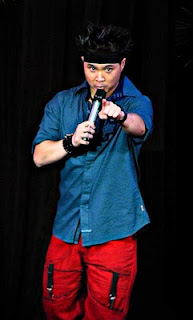
 Paws for Laughter is a Comedy Standup Fundraiser for San Francisco’s Rocket Dog Rescue, to be held on Saturday night, January 15th, 8 pm at Fort Mason’s Southside Theater in San Francisco and starring co-headliners Jeff Applebaum and Steven Pearl. Also appearing are Josh Applebaum, Coree Spencer, Max Curry, Sam Obeid and special guests. Tickets are $30 each and available by calling (415) 994-5335 or buying online at http://www.brownpapertickets.com/. Doors open at 7 pm.
Paws for Laughter is a Comedy Standup Fundraiser for San Francisco’s Rocket Dog Rescue, to be held on Saturday night, January 15th, 8 pm at Fort Mason’s Southside Theater in San Francisco and starring co-headliners Jeff Applebaum and Steven Pearl. Also appearing are Josh Applebaum, Coree Spencer, Max Curry, Sam Obeid and special guests. Tickets are $30 each and available by calling (415) 994-5335 or buying online at http://www.brownpapertickets.com/. Doors open at 7 pm.Steven Pearl is a well-respected comedian whose been compared to a tornado on hyper drive. His high-energy comedy act is both outrageous and hysterically original. Born in Far Rockaway, New York, and raised on Long Island, Steven Pearl has been performing stand-up comedy professionally since 1979. He began his stand-up career in such prestigious NYC comedy clubs as "Catch A Rising Star" and "The Improv", moving to San Francisco in 1979. In San Francisco he immersed himself in the comedy scene and was often performing seven nights a week. By 1985, he found himself opening for the then up and coming L.A. based comic Sam Kinison. He eventually discovered a comedian could only go so far in San Francisco and moved on to Los Angeles in 1987.Some of his many credits include writing for and working with such comedic legends as Sam Kinison, Bill Hicks, Jim Carrey, Robin Williams and Rodney Dangerfield. A true journeyman comic, Steven Pearl continues to push the envelope of both good taste and sanity.
Comic Jeff Applebaum is a New York native who has finally learned how to speak English after living in California for 19 years. Jeff’s clean comedy act examines his particular life experiences, which include being the only white kid on his Little League team in Queens, having a Chinese wife who orders from take-out menus in fluent Mandarin, and raising a pre-teen son who calls himself “Jewnese,” because he says it sounds better than “Chine-ish.”
Jeff recently made his national TV debut on CBS as a comedian on the "Late Late Show with Craig Ferguson and was cast to play classic comic Joey Bishop, in the long-running musical tribute "The Rat Pack Is Back," in San Francisco, Chicago, and Las Vegas. Jeff is also credited and appears in the blockbuster film "The Pursuit of Happyness," starring Will Smith.
Rocket Dog Rescue is an all-volunteer nonprofit group dedicated to saving homeless and abandoned animals from euthanasia in overcrowded Bay Area shelters. Rocket Dog Rescue places non-aggressive dogs into temporary foster homes where they are socialized, spay/neutered, vaccinated, and treated for any medical or behavioral conditions which would otherwise limit their adoptability. The organization then actively seeks out permanent quality homes for these deserving animals through our volunteer network, online adoption page, weekend adoption fairs, and neighborhood poster campaigns.
Founded in 2001 by Bay Area animal activist Pali Boucher, Rocket Dog Rescue is a 501-C3 nonprofit corporation supported completely by donations. Their all-volunteer, home-based organization guarantees that your donations are completely focused on saving dogs.






 He's the oldest living MLB baseball player on the planet and it was a pleasure meeting and interviewing the 100-year old Tony Malinosky. He played only one season for the Brooklyn Dodgers, but he fought in the Battle of the Bulge and one of his college buddies was Richard Nixon. He's lived an amazing life and next month he'll turn 101!
He's the oldest living MLB baseball player on the planet and it was a pleasure meeting and interviewing the 100-year old Tony Malinosky. He played only one season for the Brooklyn Dodgers, but he fought in the Battle of the Bulge and one of his college buddies was Richard Nixon. He's lived an amazing life and next month he'll turn 101!
























